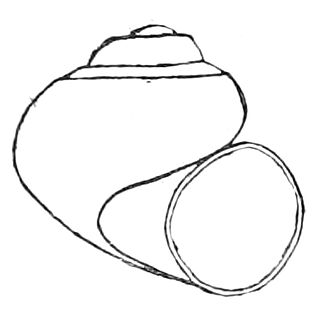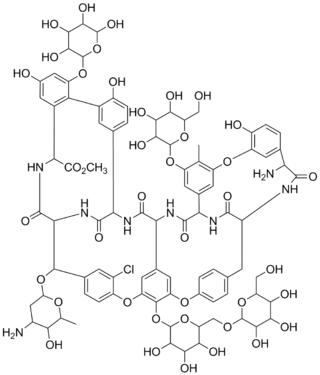
A coccus is any bacterium or archaeon that has a spherical, ovoid, or generally round shape. Bacteria are categorized based on their shapes into three classes: cocci (spherical-shaped), bacillus (rod-shaped) and spiral. Coccus refers to the shape of the bacteria, and can contain multiple genera, such as staphylococci or streptococci. Cocci can grow in pairs, chains, or clusters, depending on their orientation and attachment during cell division. In contrast to many bacilli-shaped bacteria, most cocci bacteria do not have flagella and are non-motile.

Torosaurus is a genus of herbivorous ceratopsid dinosaur that lived during the late Maastrichtian stage of the Cretaceous period, between 68 and 66 million years ago, though it is possible that the species range might extend to as far as 69 million years ago. Fossils have been discovered across the Western Interior of North America, from Saskatchewan to southern Texas.

Anidulafungin (INN) is a semisynthetic echinocandin used as an antifungal drug. It was previously known as LY303366. It may also have application in treating invasive Aspergillus infection when used in combination with voriconazole. It is a member of the class of antifungal drugs known as the echinocandins; its mechanism of action is by inhibition of (1→3)-β-D-glucan synthase, an enzyme important to the synthesis of the fungal cell wall.

Stagnicola utahensis, common name the thickshell pondsnail, is a species of air-breathing freshwater snail, an aquatic pulmonate gastropod mollusk in the family Lymnaeidae, the pond snails. This species is endemic to Utah Lake in the United States. The last living snails were found in the 1930s.

The Utah roundmouth snail, also known as the Utah valvata or desert valvata, scientific name Valvata utahensis, is a species of freshwater snail with a gill and an operculum, an aquatic gastropod mollusc in the family Valvatidae, the valve snails.
In enzymology, an aculeacin-A deacylase is an enzyme that catalyzes the chemical reaction that cleaves the amide bond in aculeacin A and related neutral lipopeptide antibiotics, releasing the long-chain fatty acid side chain.

Agave utahensis is a species of agave known by the common name Utah agave.

Echinocandin B, a lipopeptide, is a naturally occurring cyclic hexapeptide with a linoleoyl side chain. It belongs to a class of antifungal agents called echinocandins, which inhibits the synthesis of glucan, a major component of the fungal cell wall, via noncompetitive inhibition of a crucial enzyme, β-(1→3)-D-glucan synthase. Echinocandin B is a fermentation product of Aspergillus nidulans and the closely related species, A. rugulosus; discovered in 1974 in A. nidulans var. echinulatus strain A 32204 in Germany, it was the first of the echinocandin class of antifungals.

Catocala delilah, the Delilah underwing, is a moth in the family Erebidae. The species was first described by Strecker in 1874. It is found in the southern and midwestern United States, from Ohio south to Florida and west to Texas and Oklahoma.

Valienamine is a C-7 aminocyclitol found as a substructure of pseudooligosaccharides such as the antidiabetic drug acarbose and the antibiotic validamycin. It can be found in Actinoplanes species.
Actinoplanes is a genus in the family Micromonosporaceae. They have aerial mycelia and spherical, motile spores. Actinoplanes species produce the pharmaceutically important compounds valienamine, teicoplanin, and ramoplanin.

Actinoplanes italicus is distinguished by the cherry-red color of its vegetative mycelium, and by the production of soluble pigments. It is also known to produce sporangia when cultured on starch or skim milk agar. Very few strains have been found and cultured, thus A. italicus is relatively uncharacterized.

Actaplanin is a complex of broad-spectrum antibiotics made by Actinoplanes bacteria. Research carried out by a group in Eli Lilly and Co. in 1984 identified several actaplanins using high-performance liquid chromatography. Actaplanins A, B1, B2, B3, C1 and G were shown to be composed of the same peptide core, an amino sugar, and varying amounts of glucose, mannose, and rhamnose.

Actagardin is a tetracyclic peptide lantibiotic made by Actinoplanes brasiliensis. It was discovered in 1975 by Lepetit S.p.A. It's method of antibiotic activity involves the inhibition of peptidoglycan, preferentially targeting gram negative bacteria.
Actinoplanes capillaceus is a bacterium from the genus Actinoplanes which has been isolated from soil in Sayama, Japan.
Actinoplanes luteus is a bacterium from the genus Actinoplanes which has been isolated from forest soil from Lamphun, Thailand.
Actinoplanes nipponensis is a Gram-positive and antibiotic-producing bacterium from the genus Actinoplanes which has been isolated from soil from Japan.

In microbiology, colonial morphology refers to the visual appearance of bacterial or fungal colonies on an agar plate. Examining colonial morphology is the first step in the identification of an unknown microbe. The systematic assessment of the colonies' appearance, focusing on aspects like size, shape, colour, opacity, and consistency, provides clues to the identity of the organism, allowing microbiologists to select appropriate tests to provide a definitive identification.

Mycobacterium ulcerans is a species of bacteria found in various aquatic environments. The bacteria can infect humans and some other animals, causing persistent open wounds called Buruli ulcer. M. ulcerans is closely related to Mycobacterium marinum, from which it evolved around one million years ago, and more distantly to the mycobacteria which cause tuberculosis and leprosy.
The Streptosporangiaceae are a family of bacteria.












